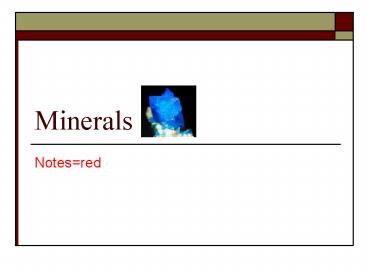Minerals - PowerPoint PPT Presentation
1 / 20
Title:
Minerals
Description:
Scientists have organized mineral properties into categories to help ... fluorescence, optical properties, radioactivity, magnetism, taste, and reactions ... – PowerPoint PPT presentation
Number of Views:66
Avg rating:3.0/5.0
Title: Minerals
1
Minerals
- Notesred
2
What is a mineral?
- Mineral- A mineral is a naturally formed,
inorganic solid with a crystalline structure. - Not all minerals look like gems in fact, most
look like rocks! Rocks are actually made of many
minerals but minerals are not made of rocks.
3
Mineral vs Rock
- In order to be a mineral, it must have these four
properties - It has to be a solid
- It has to be formed in nature
- It has to be inorganic
- It has to have a crystalline structure
- But what do those mean?
4
Solid
- The three phases of matter are solid, liquid, and
gas. - A solid has a defined shape it does not change.
- Minerals cannot be liquids or gases but can be
found in and around liquids and gases.
5
Formed in nature
- In order to be a mineral, it has to be created in
nature. - There are many things that are man-made items.
These items, which can even sometimes look like
minerals, are not minerals because they do not
form in nature! - It has to be naturally occurring!! Something you
could dig up or find lying around.
6
Inorganic
- Inorganic means not organic or not living
- Minerals must be things that are not alive.
7
Crystalline structure
- When you think of crystals you usually think of a
rigid structure. The exact shape depends on the
arrangement of atoms. - Almost all minerals are made of the one chemical
composition throughout.
8
Chemical composition?
- composition what something is made of
- Minerals are made of elements. All minerals
have one or more of the 92 elements that are
present on the Earths crust.
9
More on elements
- An element is made of only one kind of atom.
- An atom is the basic unit of an element.
- Some minerals have more than one element. These
minerals are made of compounds of elements.
(think compound words) - A compound has 2 or more elements that are bonded
together.
10
Types of minerals
- There are two major types of minerals
- Silicate minerals contain a combination of
silicon and oxygen. - 90 of the Earths crust are silicate minerals
- Nonsilicate minerals do not have a combination of
silicon and oxygen. - Some examples are carbon, oxygen, iron, and
sulfur.
11
Properties of minerals
- How can you tell two minerals apart? Scientists
have organized mineral properties into categories
to help identify unknown minerals. - The seven major properties of minerals are
- Color, luster, streak, cleavage, fracture,
hardness, and density.
12
Color
- What color you see
13
Luster
- How the mineral reflects light. Think shiny
and dull
14
Streak
- The color of the mineral when in powder form.
Color does not equal streak!!! - In order to find streak, the mineral needs to be
rubbed against a porcelain streak plate.
15
Cleavage
- How often a mineral breaks along a flat surface
16
Fracture
- How often a mineral breaks unevenly, curved, or
rigidly. (Think fractured bones!)
17
Hardness
- How resistant the mineral is to being scratched.
- Uses Mohs hardness scale
18
Density
- How much matter (mass) is in the amount of space
(volume). (remember Dm/v?) - The bones below have the same volume but
different densities.
19
Other properties
- Some minerals have other special properties.
- They are fluorescence, optical properties,
radioactivity, magnetism, taste, and reactions to
chemicals.
20
Homework
- Read pages 60-66
- Do page 63 1-4 in your science notebook
- Note that you are not doing page 66 homework
questions. Those will be assigned next class.































